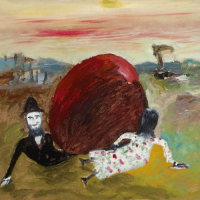64. SIDNEY NOLAN

Sidney Nolans universally acclaimed achievement is the first Ned Kelly series of paintings produced while the artist lived at Heide, the home of John and Sunday Reed, and first exhibited in Melbourne in 1948. 27 of these celebrated paintings were donated by Sunday Reed to the collection of the National Gallery of Australia in Canberra - the remaining work, First Class Marksman, was acquired by the Art Gallery of NSW, having set an Australian record at auction in 2010. In addition to these particular paintings, Nolan also produced other related Kelly works between 1945 and 1947: some are drawings, some preparatory painting sketches, some fully realised works that were not included in the exhibition of 1948.
Very few of these ancillary Kelly works now remain in private hands. The painting, Kate Kelly Pursued by Constable Fitzpatrick, is one such work. It was most probably painted in 1945, the year that Nolan first addressed the Ned Kelly theme and has remained in the collection of the artist until his death in England in 1992, testifying to the immense personal significance that Nolan gave to these very first Kelly paintings. This painting, together with its significant provenance, makes this a work of considerable historical importance. In works such as this, the artist first began to explore the theme of the historical Kelly, while also searching for the unique set of formal devices through which he encapsulated the complex symbolism of the Kelly myth. The most notable of these devices was, of course, to be the black square representation of the iron helmet worn into battle during the siege at Glenrowan by our most famous Australian bushranger.
The Kelly paintings were the outcome of intense research by the artist into the historical facts of the Kelly story, and the series is focussed around the key events of this great Australian drama. One such decisive moment is the subject of this painting: the sexual harassment of Ned Kellys sister Kate by the young Constable Alexander Fitzpatrick who had arrived at the Kelly homestead in April 1878 intending to arrest Neds brother Dan Kelly for horse stealing. The whole business ended in an altercation between Fitzpatrick and the Kellys, and Fitzpatricks subsequent ignominious flight from the homestead and as such was a precipitating act that in its own way might be likened to that of Helens elopement with Paris, leading directly to the fall of Troy some ten years later. In terms of our own antipodean myth-making, here was the pivotal moment that was to drive Ned and his associates into outlawry, setting in motion the subsequent cycle of tragic events that led inexorably to the outlaws final capture, trial and execution in 1880.
Nolan would later locate this confrontational moment (as depicted in the painting dated October 1946, Constable Fitzpatrick and Kate Kelly, National Gallery of Australia, Canberra) as taking place inside the Kelly homestead as Fitzpatrick attempts to pull Kate onto his knee. An armoured Ned Kelly in the distance, now already now forced into exile, can be viewed through a window. As research now reveals, the space Nolan depicts here is in fact that of the familiar kitchen in Heide, with its wood stove and flower patterned wall paper - and that the figure of Kate Kelly resembles that of Sunday Reed, Nolans lover and patron at this time. In making these connections the artist contrives not only to represent an historical event but also to suggest something of the personal turmoil and conflict of his own life in the immediate post-war years.
What is true of the 1946 painting equally appears to apply to the earlier painting of 1945 although with significant differences. Though painted in a freer and looser manner (the background landscape and dramatic crimson-streaked sky is expressionistic in style) the artist employs the painterly nave style of other paintings from this time in depicting the figures of the two protagonists. Moreover, a far more violent struggle is taking place. The uniformed figure of Fitzpatrick, now down on his hands and knees (the face a lecherous, leering mask) pursues the adolescent girl who falls to the ground in her frantic efforts to escape. Like a grotesque merry-go-round of lust and fear, the two figures encircle a large dark bush most likely a smoke bush shrub with its crimson-purple foliage from the already celebrated Reed garden at Heide.
This painting of 1945 is thus a work of immense aesthetic, psychological and historic interest. Here we find Sidney Nolans initial thoughts as to how he might depict this key moment in the Ned Kelly myth - the intense psycho-sexual drama of the struggle between Fitzpatrick and Kate Kelly and perhaps, too, a parallel drama located within Nolans own personal struggle for autonomy and freedom.
Reference:
Haese, R., Rebels and Precursors: The Revolutionary Years of Australian Art, Allen Lane, Melbourne, 1981.
Pearce, B., Sidney Nolan, Retrospective Exhibition, Art Gallery of New South Wales, Sydney, 2007.
Rosenthal, T.G., Sidney Nolan, Thames & Hudson, London, 2002.
Exhibition Catalogue, The Ned Kelly Paintings: Nolan at Heide 1946-1947, Heide Museum of Modern Art, Melbourne, 1997.
Richard Haese
PhD, Monash University; Dip Art, South Australian School of Art; BA Hons, Adelaide University
Honorary Research Associate, La Trobe University
Dr. Haese is a world authority on Sidney Nolan and is, amongst other publications, the author of the prize winning book Rebels and Precursors: the Revolutionary Years of Australian Art.